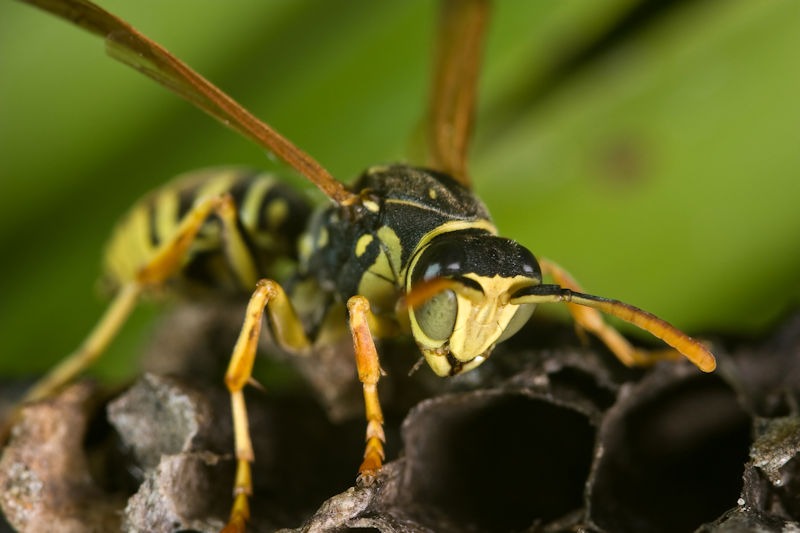Yellow jackets, known for their aggressive nature and painful stings, are a common nuisance in Southern Maryland and Northern Virginia. These wasps often establish nests in close proximity to human activity, making it essential for homeowners to implement effective habitat control measures. By understanding yellow jackets’ nesting habits and taking proactive steps to deny them access and suitable habitats, you can maintain a safer, more enjoyable outdoor space.
Identifying Potential Nesting Sites
Yellow jackets typically build their nests in two primary locations: underground and in elevated areas. Common sites include:
- Underground burrows: Often utilizing abandoned rodent holes, these nests can be difficult to spot until disturbed.
- Under eaves and structures: Yellow jackets also favor cavities in walls, attics, and eaves for nesting, especially where there is little disturbance.
Recognizing these potential nesting sites can help you target your preventive measures more effectively.
Sealing Entry Points
One of the most effective ways to deny yellow jackets access to your home and yard is by sealing entry points. Here are some tips:
- Inspect and seal cracks: Regularly inspect your home’s exterior for cracks, holes, and gaps, and seal them using caulk or expanding foam.
- Install screens: Ensure that all windows, doors, and vents are fitted with tight-fitting screens to prevent yellow jackets from entering.
- Use mesh: Cover larger openings, such as attic vents and chimney tops, with fine mesh to keep these pests out [oai_citation:1,How to Get Rid of Yellow Jackets for Good in 7 Simple Steps](https://www.bobvila.com/articles/how-to-get-rid-of-yellow-jackets/) [oai_citation:2,How To Keep Yellow Jackets Away From Your Yard | Alta](https://www.altapestcontrol.com/blog/how-to-keep-yellow-jackets-away-from-your-yard).
Yard Maintenance Practices
Maintaining a clean and clutter-free yard is crucial in reducing yellow jacket nesting sites:
- Regular mowing and trimming: Keep your lawn mowed and trim back shrubs and trees to reduce the cover available for nesting.
- Debris removal: Remove piles of leaves, grass clippings, and other yard debris promptly to eliminate potential nesting materials.
- Proper waste management: Keep trash bins sealed tightly and store them away from your house to minimize attractants [oai_citation:3,Why Do I Have So Many Yellow Jackets In My Yard | Storables](https://storables.com/maintenance-and-safety/pest-control-solutions/why-do-i-have-so-many-yellow-jackets-in-my-yard/) [oai_citation:4,Yellow Jacket Behavior, Potential Threats, Habitat & More](https://www.arrowexterminators.com/learning-center/pest-library/stinging/yellowjackets).
Creating Unattractive Habitats
Making your yard less attractive to yellow jackets can further help in keeping them at bay:
- Landscaping techniques: Avoid planting flowers and shrubs that are known to attract yellow jackets. Instead, consider plants that act as natural deterrents, such as eucalyptus, spearmint, and thyme.
- Minimize water sources: Fix leaky faucets, remove standing water, and ensure that bird baths are regularly emptied to reduce water availability for yellow jackets [oai_citation:5,Why Do I Have So Many Yellow Jackets In My Yard | Storables](https://storables.com/maintenance-and-safety/pest-control-solutions/why-do-i-have-so-many-yellow-jackets-in-my-yard/) [oai_citation:6,What’s Attracting Yellow Jackets To Your Yard? | Action Pest Control](https://www.actionpest.com/blog/2016/july/whats-attracting-yellow-jackets-to-your-yard-/).
Use of Physical Barriers
Physical barriers can be highly effective in preventing yellow jackets from establishing nests:
- Mesh and netting: Use mesh or netting to cover potential nesting sites, such as under decks or around garden sheds.
- Screens on windows and doors: Ensure that all entry points to your home are equipped with properly fitting screens to keep yellow jackets out [oai_citation:7,Yellow Jacket Behavior, Potential Threats, Habitat & More](https://www.arrowexterminators.com/learning-center/pest-library/stinging/yellowjackets) [oai_citation:8,What’s Attracting Yellow Jackets To Your Yard? | Action Pest Control](https://www.actionpest.com/blog/2016/july/whats-attracting-yellow-jackets-to-your-yard-/).
Conclusion
By identifying potential nesting sites, sealing entry points, maintaining your yard, creating unattractive habitats, and using physical barriers, you can effectively deny yellow jackets access and suitable habitats in your yard. These measures, combined with regular monitoring and professional pest control services when necessary, will help you maintain a safe and enjoyable outdoor environment free from these aggressive pests.
FAQs
Q1: What are the signs of a yellow jacket nest?
A: Look for increased yellow jacket activity in specific areas, small piles of dirt or stones around burrow entrances, and visible nests under eaves or in wall cavities.
Q2: How can I safely remove a yellow jacket nest?
A: It is highly recommended to contact a professional pest control service to handle nest removal, as yellow jackets can be very aggressive and pose significant risks when disturbed.
Q3: What natural deterrents can I use against yellow jackets?
A: Plants like eucalyptus, spearmint, and thyme can act as natural repellents. Additionally, using decoy nests and minimizing sugary foods and water sources can help deter them.
Q4: Why do yellow jackets become more aggressive in late summer?
A: As food sources become scarce towards the end of summer, yellow jackets become more aggressive in their search for sustenance, increasing the likelihood of human encounters and stings.
References
- [Bob Vila: How to Get Rid of Yellow Jackets for Good in 7 Simple Steps](https://www.bobvila.com)
- [Storables: Why Do I Have So Many Yellow Jackets In My Yard](https://www.storables.com)
- [Alta Pest Control: How To Keep Yellow Jackets Away From Your Yard](https://www.altapestcontrol.com)
- [Arrow Exterminators: Yellow Jacket Behavior, Potential Threats, Habitat & More](https://www.arrowexterminators.com)
- [Action Pest Control: What’s Attracting Yellow Jackets To Your Yard?](https://www.actionpest.com)
NEED HELP?
If you live in Southern Maryland, or Northern Virginia
FIND YOUR SOLUTION HERE
People, Pet & Pollinator Safe! Pest control for people who care.

